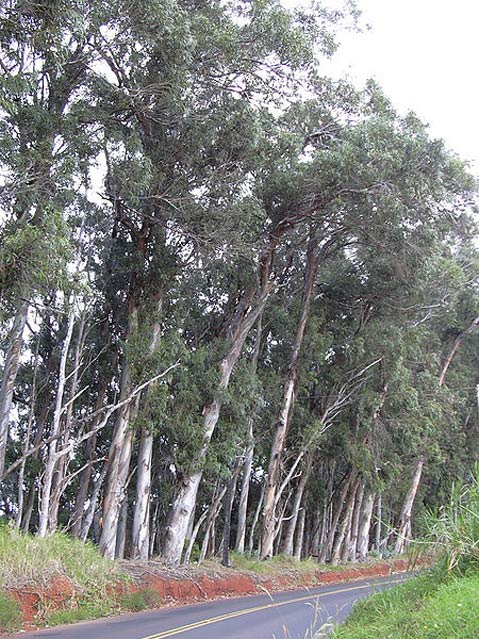How the Eucalyptus Came to California
A Cautionary Tale
It seems harmless enough; how can releasing just a few plants or animals into a new area hurt anything? But again and again, we’ve seen just how devastating introducing a foreign organism can be, whether it was on purpose or inadvertent. This has led to declining populations of bats, honeybees, and amphibians, among others, and explosive population increases among garden snails in California. Even when it doesn’t look like the non-native organism is doing any harm, it’s still tilting a biological scale that had carefully balanced itself over millennia.

When we think of organisms being introduced to new lands and wreaking havoc upon the natives, animals more readily come to mind than plants do. But the often over-looked plant invaders have significantly sculpted the California landscape to become what we know it to be today. Europeans started to settle in California in the late 1700s, and soon many non-native plant species made their way to California as well. By the early 1800s, there were 16 non-native plant species, but this jumped to about 134 species by 1860. The number has been increasing ever since; today, there are over 1,000 non-native plant species living in California (and nearly 5,000 native species). While less than 10 percent of these non-native plants are considered to be a “serious threat” to native organisms, every new plant affects its environment in ways both subtle and profound.
Introducing “aliens”: Just how much damage can a few non-native plants do? A great deal. For example, they compete with native plants for nutrients. They can in some cases alter nutrient levels in the soils (such as nitrogen levels) such that the entire local environment becomes changed and undesirable for native plants and animals. This can in turn prompt even more non-native plants, animals, and microorganisms to become established in these “disrupted” areas. The entire ecosystem’s balance can be thrown off.
While not all non-native plants and animals cause such noticeable damage to their new environments, the potential for serious disruption is always present, and each should be introduced with premeditation and educated planning. The story of how the eucalyptus came to be embedded in much of California’s scenery is a great example of lack of forethought when introducing a plant to a new area.
Australian roots: In 1770, eucalyptus specimens made their way to Europe for the first time. On his first Pacific Ocean trip, Captain James Cook explored part of the Australian coast. Botanists onboard catalogued and collected several different species along the way, taking them back to London. European botanists gave the trees the name “eucalyptus” because of how the flowers are in hard, protective cup-like structures: The Greek root “eu” means “well” and “calyptos” means “covered.”
Soon, interest in the eucalyptus swelled in Europe. In the early 1800s, wealthy merchants and aristocrats were excited about rare or “exotic” plants and, together with people in the plant business, made cultivating eucalyptus trees popular. Horticulturists also wanted to better study such novelties, to understand them scientifically and see what their potential economic value might be. And of course, the new European settlers in Australia were eager to make some money selling the abundant eucalyptus. Promoters touted the trees as not only aesthetically pleasing, but as capable of satisfying many practical needs. The eucalyptus quickly spread in Europe.
Eucalyptus is a very large genus that consists of over 600 species, which natively live in Australia, Tasmania, and some surrounding islands, in a range of soil conditions and temperatures (though prolonged frost is usually detrimental). They do very well in Australia; 80 percent of Australia’s open forests are eucalyptus trees. With some aromatic species majestically soaring over 300 feet tall, as a hardwood tree their height is second only to California’s coastal sequoias. It’s easy to see their appeal.
On an economic level, many early promoters believed the eucalyptus could be used for making a number of materials: timber, fuel, medicine, wood pulp, honey, and both medicinal and industrial oils. Not only could eucalyptus grow quickly in many conditions, but, in several species, when the tree’s cut down even to the roots new stems sprout back up. It all seemed too good to be true. Later, it turned out, it was.
The eucalyptus goes to California: Following its spread throughout Europe, northern Africa, India, and South America, settlers in California became increasingly interested in the eucalyptus. Not only was eucalyptus a fascinating novelty, but the California Gold Rush of the late 1840s and early 1850s created high demand for wood for constructing buildings and for fuel. Deforestation had become a serious concern, so much so that the California Tree Culture Act of 1868 was created to encourage people to plant more trees, particularly along roads. Many entrepreneurs rushed to capitalize on the situation.
Ellwood Cooper’s role in spreading eucalyptus: Ellwood Cooper, educator, entrepreneur, and one of the key individuals who helped the eucalyptus take off in California, is a local legend here in Santa Barbara. After seeing eucalyptus in the San Francisco area, Cooper settled down in Santa Barbara in 1870. On his ranch, among many different types of produce trees (including olives, walnuts, and figs), he grew over 200 acres of eucalyptus. The eucalyptus forest he started lives on to this day at the Ellwood Bluffs. Cooper became a vocal advocate for the eucalyptus, emphasizing its unique, aesthetically pleasing appearance, as well as its useful qualities. He even wrote the first book in the U.S. on the trees. Eucalyptus became very appealing to foresters in the 1870s and 1880s as native hardwoods were being severely depleted.
Starting in the 1870s, the first large-scale commercial planting of the blue gum eucalyptus (E. globulus) began. The blue gum, a mid-sized eucalyptus reaching around 150 to over 200 feet tall, is the most common eucalyptus in California. These trees are easily recognized by their waxy blue leaves and a grayish bark which reveals a smooth, contrasting yellowish surface when the bark sheds off in long strips. As with many other eucalyptus species, sprouts can grow back from a fallen tree stump.
By the early 1900s, the get-rich mindset had caused many aspiring forest tycoons to plant countless acres of eucalyptus in hopes of selling the timber for a tidy profit. It’s estimated that there were over 100 companies involved in the eucalyptus industry at this time, and they changed the landscape of much of California.
But investors were soon to discover that the eucalyptus weren’t all they’d hoped them to be.
Sadly, most of these schemes went the way they infamously did for Frank C. Havens. Havens was an Oakland developer who opened a mill and planted eight million eucalyptus trees in a 14-mile-long strip from Berkeley through Oakland. But when he came to sell the timber, it was found that the trees were too young to make suitable wood; the young wood had an irregular grain and it bent, cracked, and shrank when dried. It is true that eucalyptus trees from Australia could make good timber, but those trees were decades or sometimes centuries old. It was soon found that eucalyptus trees would need to be at least 75 or 100 years old for good lumber. The young wood didn’t even make useable fence posts or railroad track ties, both of which decayed rapidly. Havens closed shop.
Other options for selling California-based eucalyptus products were grim. In the early 1920s, it was realized that California eucalyptus oil wasn’t nearly the same quality as foreign-made oil, again mainly from Australia. The wood became increasingly sold just for fuel, but cheap electricity and gas soon replaced it. By 1950, eucalyptus trees were primarily grown in California as ornamentals or windbreaks. The trees had failed to live up the many premature claims and hopes.
Eucalyptus recently: Today, millions of acres globally are covered by eucalyptus, as forests, shade trees, anchors along canals, ornamentals, windbreaks, or plantations. Their adaptability allows them to grow where other plants can’t, such as lands that have been ruined by mining or poor agricultural practices. They’re still used in medical products (including antiseptics, decongestants, and stimulants), foods (such as cough drops and sweets), perfumes, toothpastes, industrial solvents, menthol cigarettes, and more. (But be careful, because eucalyptus bark and leaves, and consequently eucalyptus oil, are toxic if ingested or absorbed through the skin at high doses. It’s especially poisonous to cats.) Eucalyptus is also a source of quality pulp. In a controversial case of history potentially repeating itself, these factors have caused eucalyptus plantations to crop up in many developing countries, particularly in Thailand. Due to the contentious social and environmental impacts of this, much criticism has been cast upon the international corporations spearheading these projects.
In addition to these new plantations, there are other divisive issues surrounding the eucalyptus today. Blue gum can be invasive in California, aggressively spreading from its original planting if enough water is present, such as in the form of fog. The bark strips dropped by the blue gums are extremely flammable, which can lead to intense fires, such as the Oakland Firestorm of 1991.
Additionally, in eucalyptus groves outside of their native homes, ecosystem development faces many challenges. Because most eucalyptus trees were grown from seeds from Australia, few eucalyptus insect pests traveled with the eucalyptus to their new homes. Fifty-seven Australian mammal species that normally live in eucalyptus groves, including koalas, wallabies, and pandemelons, as well as over 200 bird species, didn’t make the voyage either. Because the eucalyptus leaves and bark are poisonous, the mammals that feed off of it had to evolve mechanisms to deal with these toxins. Other mammals won’t eat the eucalyptus. Overall, this results in a small degree of species diversity in eucalyptus groves. Australian plants and animals never arrived; native plants and animals are pushed out. While the eucalyptus is certainly not as devastating to its new home as some non-native plants and animals have been, its story should still serve as a cautionary tale: Think before you plant.
For more on eucalyptus and non-native plants, see Robin W. Doughty’s book The Eucalyptus: A Natural and Commercial History of the Gum Tree, Carla C. Bossard, John M. Randall, and Marc C. Hoshovsky’s book on Invasive Plants of California’s Wildlands, California Invasive Plant Council’s website on Invasive Plant Inventory, the University of California’s Agriculture and Natural Resources’ website on Invasive Plants, California’s Department of Fish and Game website on Invasive Species Program, a previous Santa Barbara Independent article on Ellwood Cooper and other Santa Barbara Pioneer Horticulturists, and Wikipedia’s article on Eucalyptus.
Biology Bytes author Teisha Rowland is a science writer, blogger at All Things Stem Cell, and graduate student in molecular, cellular, and developmental biology at UCSB, where she studies stem cells. Send any ideas for future columns to her at science@independent.com.



